HONDA S2000 2000 1.G Owners Manual
Manufacturer: HONDA, Model Year: 2000, Model line: S2000, Model: HONDA S2000 2000 1.GPages: 273, PDF Size: 21.58 MB
Page 201 of 273
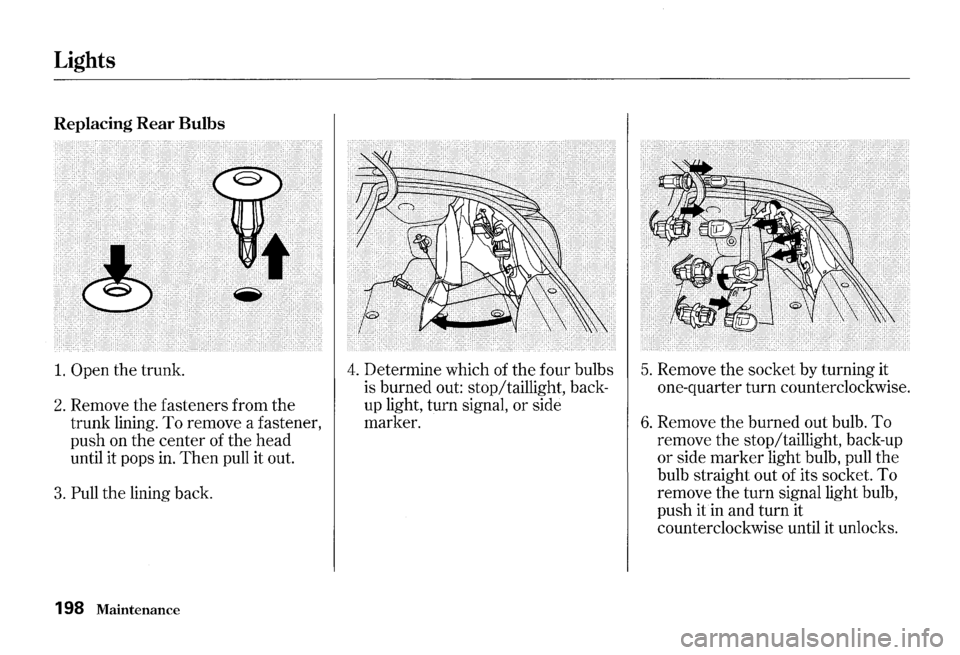
Lights
Replacing Rear Bulbs
1. Open the trunk.
2. Remove the fasteners from the
trunk lining. To remove a fastener,
push on
the center of the head
until it pops in. Then pull it out.
3. Pull the lining back.
198 Maintenance
4. Determine which of the four bulbs
is burned out: stop/taillight, back
up light, turn signal, or side
marker. 5. Remove the socket by turning it
one-quarter
turn counterclockwise.
6. Remove the burned out bulb. To
remove the stop/taillight, back-up
or side marker light bulb, pull the
bulb straight out of its socket. To
remove the turn signal light bulb,
push it in and turn it
counterclockwise until it unlocks.
Page 202 of 273
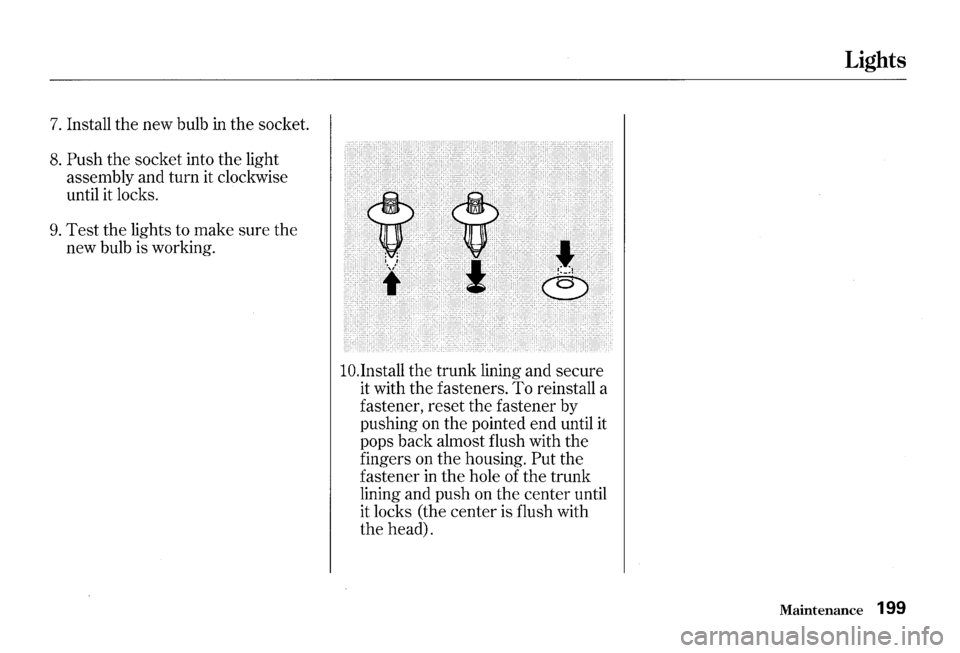
7. Install the new bulb in the socket.
8. Push the socket into the light
assembly and turn it clockwise
until it locks.
9. Test the lights to make sure the
new bulb is working.
lO.Install the trunk lining and secure
it with the fasteners. To reinstall a
fastener, reset the fastener by
pushing on the pointed end until it
pops back almost flush with the
fingers on the housing.
Put the
fastener
in the hole of the trunk
lining and push on the center until
it locks (the center is flush with
the head).
Lights
Maintenance 199
Page 203 of 273
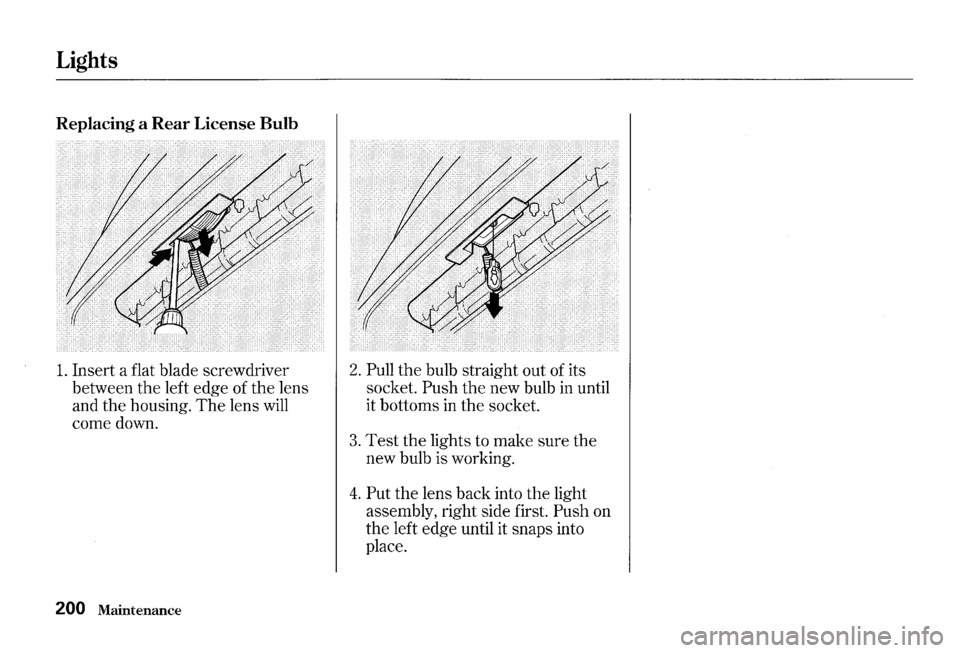
Lights
Replacing a Rear License Bulb
1. Insert a flat blade screwdriver
between
the left edge of the lens
and
the housing. The lens will
come down.
200 Maintenance
2. Pull the bulb straight out of its
socket.
Push the new bulb in until
it bottoms in
the socket.
3. Test the lights to make sure the
new bulb is working.
4. Put the lens back into the light
assembly, right side first.
Push on
the left edge until it snaps into
place.
Page 204 of 273
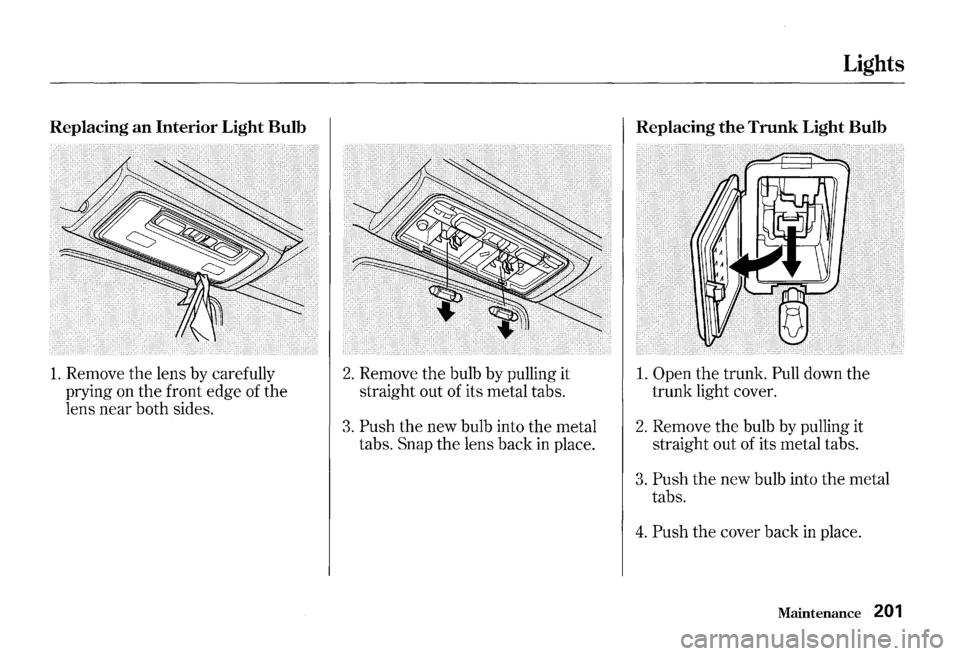
Replacing an Interior Light Bulb
1. Remove the lens by carefully
prying on
the front edge of the
lens near both sides.
2. Remove the bulb by pulling it
straight out of its metal tabs.
3. Push the new bulb into the metal
tabs.
Snap the lens back in place.
Lights
Replacing the Trunk Light Bulb
1. Open the trunk. Pull down the
trunk light cover.
2. Remove the bulb by pulling it
straight out of its metal tabs.
3. Push the new bulb into the metal
tabs.
4. Push the cover back in place.
Maintenance 201
Page 205 of 273
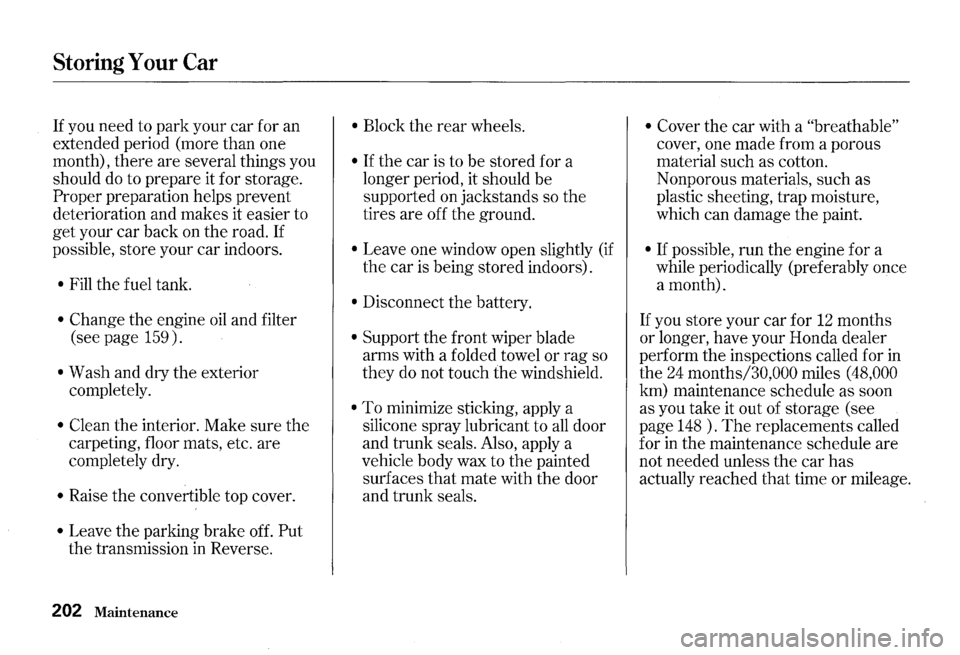
Storing Your Car
If you need to park your car for an
extended period (more than one
month), there are several things you
should
do to prepare it for storage.
Proper preparation helps prevent
deterioration and makes it easier to
get your car back on the road.
If
possible, store your car indoors.
• Fill the fuel tank.
• Change the engine oil and filter
(see page 159).
• Wash and dry the exterior
completely.
• Clean the interior. Make sure the
carpeting, floor mats, etc. are
completely dry.
• Raise the convertible top cover.
• Leave the parking brake off. Put
the transmission in Reverse.
202 Maintenance
• Block the rear wheels.
• If the car is to be stored for a
longer period, it should be
supported on jackstands so the
tires are off the ground.
• Leave one window open slightly (if
the car is being stored indoors).
• Disconnect the battery.
• Support the front wiper blade
arms with a folded towel or rag so
they
do not touch the windshield.
• To minimize sticking, apply a
silicone spray lubricant to
all door
and trunk seals. Also, apply a
vehicle body wax to the painted
surfaces that mate with the door
and trunk seals.
• Cover the car with a "breathable"
cover, one made from a porous
material such as cotton.
Nonporous materials, such as
plastic sheeting, trap moisture,
which can damage
the paint.
• If possible, run the engine for a
while periodically (preferably once
a month).
If you store your car for 12 months
or longer, have your Honda dealer
perform the inspections called for
in
the 24 months/30,000 miles (48,000
km) maintenance schedule as soon
as you take it out of storage (see
page
148 ). The replacements called
for
in the maintenance schedule are
not needed unless the car has
actually reached that time or mileage.
Page 206 of 273
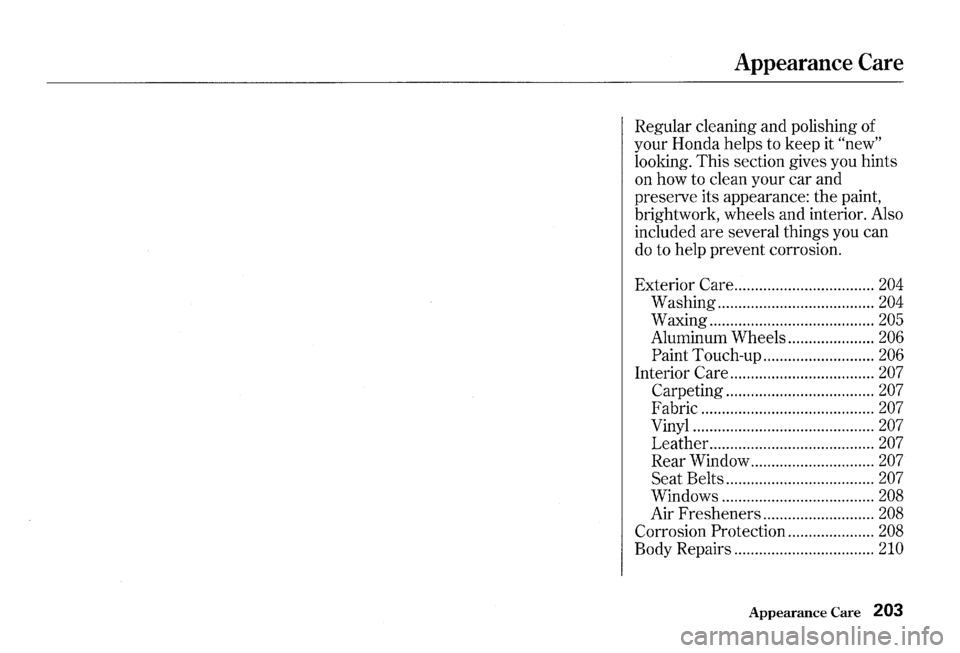
Appearance Care
Regular cleaning and polishing of
your Honda helps to keep it
"new"
looking. This section gives you hints
on how to clean your car and
preserve its appearance:
the paint,
brightwork, wheels and interior. Also
included are several things you can
do to help prevent corrosion.
Exterior
Care .................................. 204
Washing ...................................... 204
Waxing ........................................ 205
Aluminum Wheels ..................... 206
Paint Touch-up ........................... 206
Interior Care ................................... 207
Carpeting .................................... 207
Fabric .......................................... 207
Vinyl ............................................ 207
Leather ........................................ 207
Rear Window .............................. 207
Seat Belts .................................... 207
Windows ..................................... 208
Air Fresheners ........................... 208
Corrosion Protection ..................... 208
Body Repairs .................................. 210
Appearance Care 203
Page 207 of 273
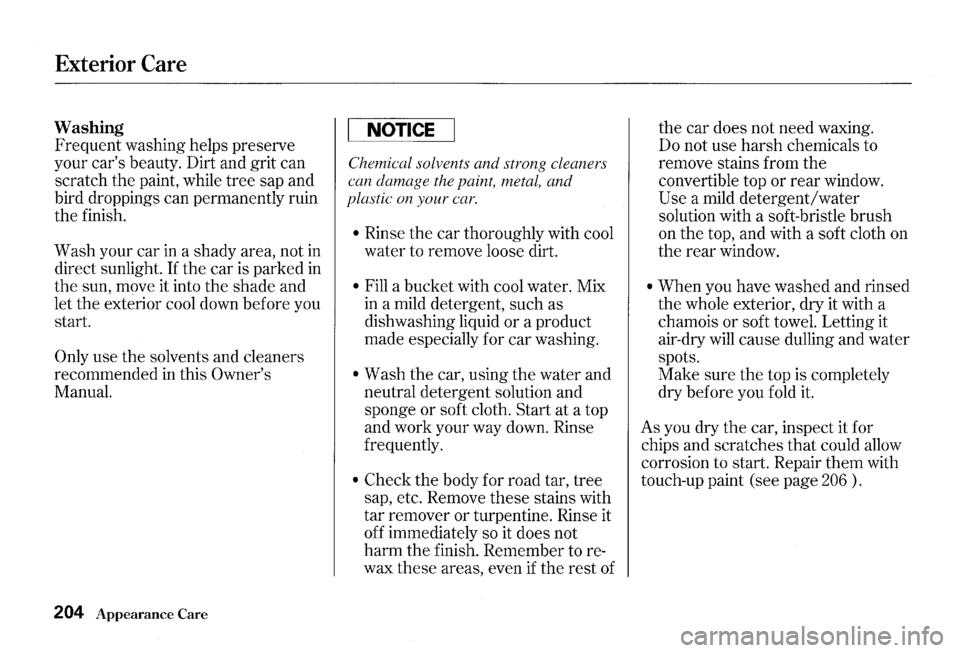
Exterior Care
Washing
Frequent washing helps preserve
your car's beauty. Dirt and grit can
scratch the paint, while tree sap and
bird droppings can permanently ruin
the finish.
Wash your car
in a shady area, not in
direct sunlight. If the car is parked in
the sun, move it into the shade and
let the exterior cool down before you
start.
Only use the solvents and cleaners
recommended
in this Owner's
Manual.
204 Appearance Care
NOTICE
Chemical solvents and strong cleaners
can
damar;e the paint, metal, and
plastic on your car.
• Rinse the car thoroughly with cool
water to remove loose dirt.
• Fill a bucket with cool water. Mix
in a mild detergent, such as
dishwashing liquid or a product
made especially for car washing.
• Wash the car, using the water and
neutral detergent solution and
sponge or soft cloth.
Start at a top
and work your way down. Rinse
frequently.
• Check the body for road tar, tree
sap, etc. Remove
these stains with
tar remover or turpentine. Rinse it
off immediately so it does not
harm the finish. Remember to re
wax these areas, even
if the rest of the
car does not need waxing.
Do not use harsh chemicals to
remove stains from the
convertible top
or rear window.
Use a mild detergent/water
solution with a soft-bristle brush
on the top, and with a soft cloth on
the rear window.
• When you have washed and rinsed
the whole exterior, dry it with a
chamois or soft towel. Letting it
air-dry
will cause dulling and water
spots.
Make sure the top is completely
dry before you fold
it.
As you dry the car, inspect it for
chips and scratches that could allow
corrosion to start. Repair
them with
touch-up paint (see page
206 ).
Page 208 of 273
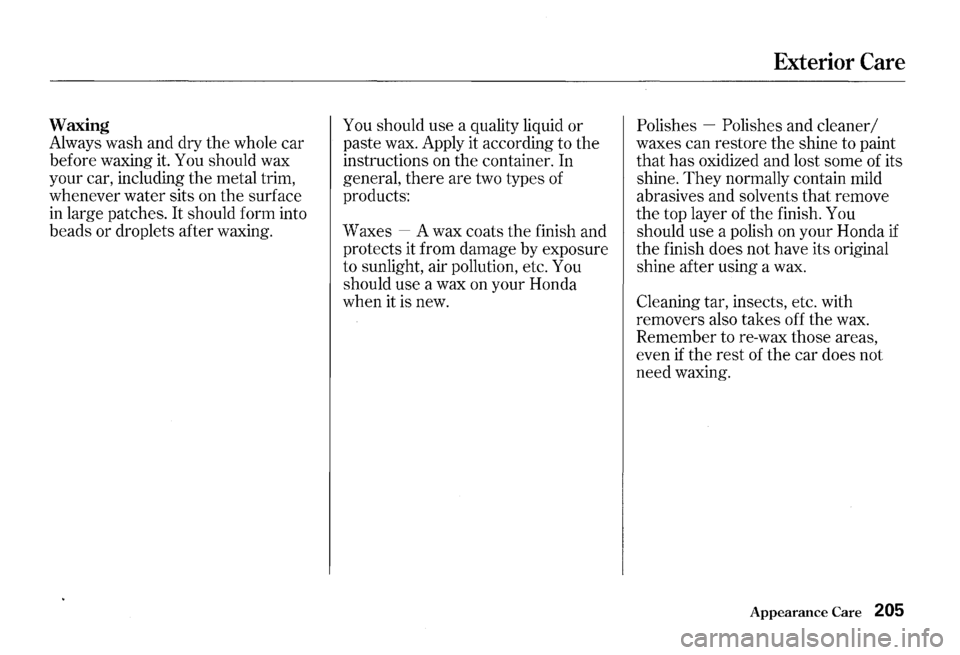
Waxing
Always wash and dry the whole car
before waxing it. You should wax
your car, including the metal trim,
whenever water sits on
the surface
in large patches. It should form into
beads or droplets after waxing. You
should use a quality liquid or
paste wax. Apply it according to the
instructions on the container. In
general, there are two types of
products:
Waxes - A wax coats the finish and
protects it from damage by exposure
to sunlight, air pollution, etc. You
should use a wax on your Honda
when it is new.
Exterior Care
Polishes -Polishes and cleaner I
waxes can restore the shine to paint
that has oxidized and lost some of its
shine.
They normally contain mild
abrasives and solvents that remove
the top layer of the finish. You
should use a polish on your Honda
if
the finish does not have its original
shine after using a wax.
Cleaning tar, insects, etc. with
removers also takes off the wax.
Remember to re-wax those areas,
even
if the rest of the car does not
need waxing.
Appearance Care 205
Page 209 of 273
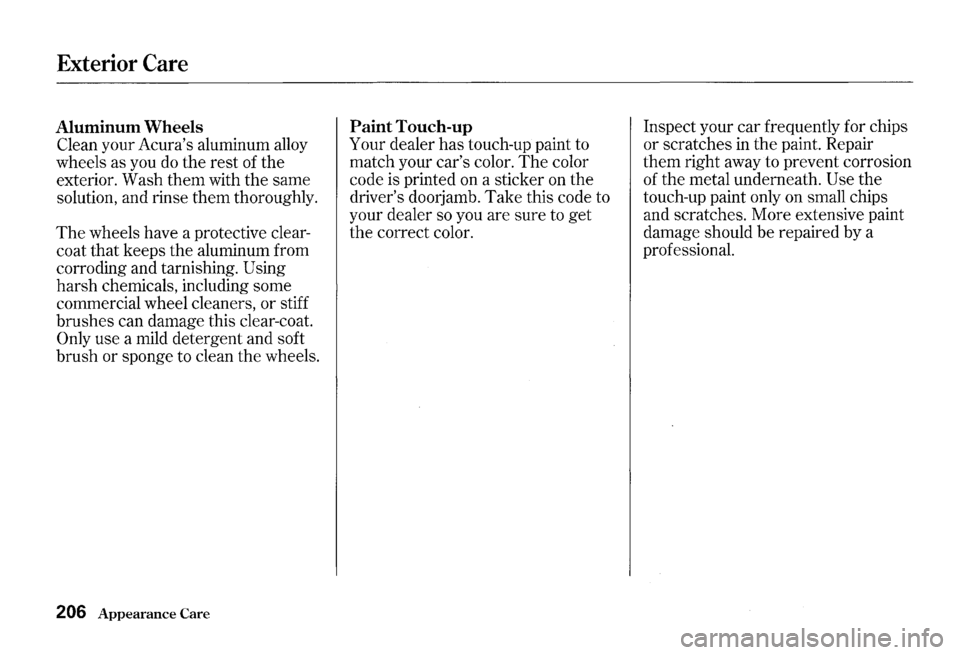
Exterior Care
Aluminum Wheels
Clean your Acura's aluminum alloy
wheels as you
do the rest of the
exterior. Wash them with the same
solution, and rinse them thoroughly.
The wheels have a protective clear
coat that keeps the aluminum from
corroding and tarnishing.
Using
harsh chemicals, including some
commercial wheel cleaners, or stiff
brushes can damage this clear-coat.
Only use a mild detergent and soft
brush or sponge to clean the wheels.
206 Appearance Care
Paint Touch-up
Your dealer has touch-up paint to
match your car's color.
The color
code is printed on a sticker on the
driver's doorjamb.
Take this code to
your dealer so you are sure to get
the correct color. Inspect
your car frequently for chips
or scratches
in the paint. Repair
them right away to prevent corrosion
of the metal underneath.
Use the
touch-up paint only on small chips
and scratches. More extensive paint
damage should be repaired by a
professional.
Page 210 of 273
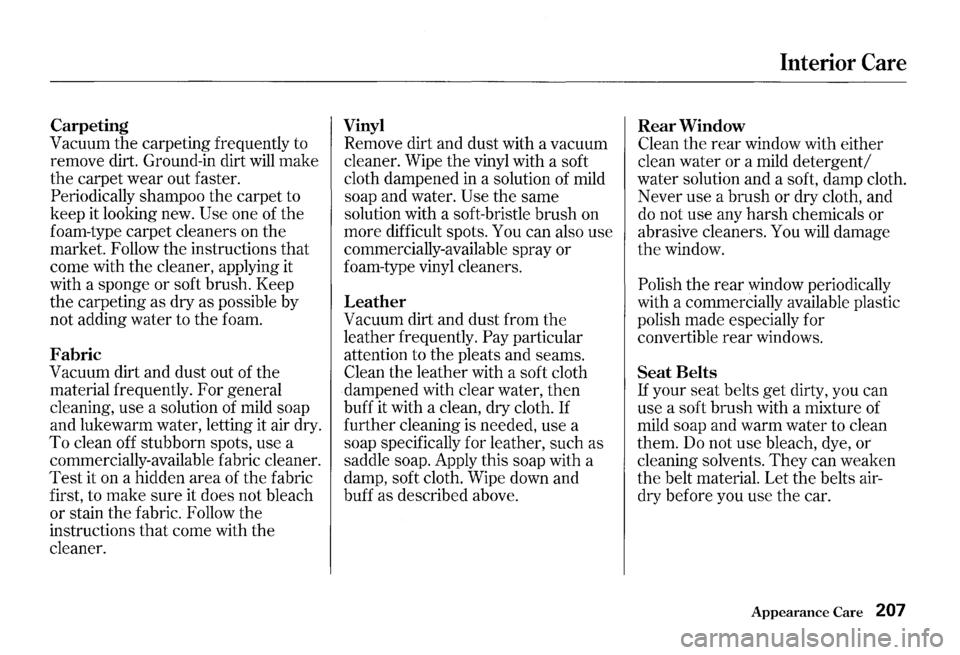
Carpeting
Vacuum the carpeting frequently to
remove dirt. Ground-in dirt
will make
the carpet wear out faster.
Periodically shampoo the carpet to
keep it looking new.
Use one of the
foam-type carpet cleaners on the
market. Follow the instructions
that
come with the cleaner, applying it
with a sponge
or soft brush. Keep
the carpeting as dry as possible by
not adding water to the foam.
Fabric
Vacuum dirt and dust out of the
material frequently. For general
cleaning, use a solution of mild soap
and lukewarm water, letting it air dry.
To clean off stubborn spots, use a
commercially-available fabric cleaner.
Test it on a hidden area of the fabric
first, to make sure it does not bleach
or stain the fabric. Follow the
instructions
that come with the
cleaner.
Vinyl
Remove dirt and dust with a vacuum
cleaner. Wipe
the vinyl with a soft
cloth dampened in a solution of mild
soap and water.
Use the same
solution with a soft-bristle
brush on
more difficult spots. You can also use
commercially-available spray
or
foam-type vinyl cleaners.
Leather
Vacuum dirt and dust from the
leather frequently. Pay particular
attention to the pleats and seams.
Clean the leather with a soft cloth
dampened with clear water,
then
buff it with a clean, dry cloth. If
further cleaning is needed, use a
soap specifically for leather, such as
saddle soap. Apply this soap with a
damp, soft cloth. Wipe down and
buff as described above.
Interior Care
Rear Window
Clean the rear window with either
clean water or a mild
detergent/
water solution and a soft, damp cloth.
Never use a brush or dry cloth, and
do not use any harsh chemicals or
abrasive cleaners. You
will damage
the window.
Polish the rear window periodically
with a
commerCially available plastic
polish made especially for
convertible rear windows.
Seat Belts
If your seat belts get dirty, you can
use a soft brush with a mixture of
mild soap and warm water to clean
them. Do not use bleach, dye,
or
cleaning solvents. They can weaken
the belt material. Let the belts air
dry before you use
the car.
Appearance Care 207